Dyson 360 Vis Nav review – Dyson's robot vacuum cleaner isn't quite perfect
The Dyson 360 Vis Nav robot vacuum is good for a robot, but still no match for the brand's latest cordless vacuum

I think the marketing information for the Dyson 360 Vis Nav over-promises, which makes it feel like the vacuum under-delivers. But in actual fact it’s as good as most other premium robot vacuums, even if it's not quite up to scratch for Dyson's cordless vacuums
-
+
Simple to configure
-
+
User friendly app
-
+
Plenty of options create bespoke cleaning schedules and zones
-
+
Four power levels
-
-
Expensive
-
-
Can miss some debris
-
-
Slow
You can trust Homes & Gardens.

Dan Fauzi
Recent updates
30 January 2024. We have revisited the original author of this review and added new information on how well the Dyson 360 Vis Nav performed months after testing. We've also updated more info on the design, features, and how it compares to newer models.
Robot vacuums are supposed to be a dream come true. Letting a robot take care of this time-consuming household chore is marketed as though you're living in the future. You can head out for a coffee and come home to spotless floors – what's not to love?
Enter Dyson's latest robot, the Dyson 360 Vis Nav. Dyson claims that the Vis Nav has 2x the suction of any other robot vacuum. It’s equipped with intelligent navigation that includes no less than 26 sensors. The brand claims it intelligently prioritizes high dust areas.
However, historically, robots have been Dyson's Achilles' heel. Their robots have never dominated the market in the way their upright and cordless vacuums have, and the robots they have put out have often been far below the standard of iRobot, Roborock, and Shark. It will take a lot for the 360 Vis Nav to end up in our guide to the best robot vacuums, let alone the best vacuum cleaners.
Product specifications
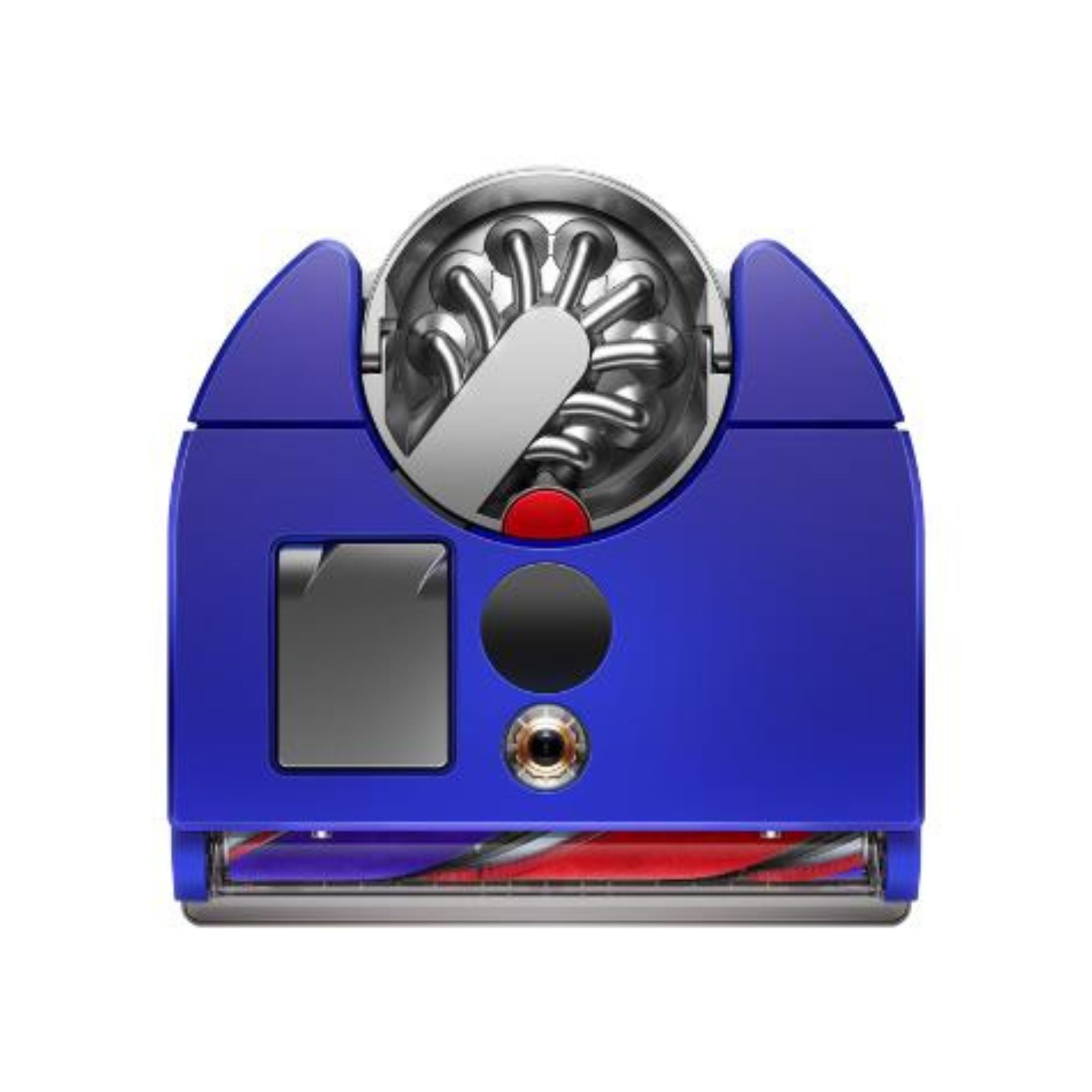
| Dust capacity: | 0.13 gal |
| Runtime: | 65 minutes |
| Charge time: | 2.75 hours |
| Weight: | 9.9 lb |
| Filter: | Whole-machine HEPA filtration |
| Suction power | 65 air watts |
| Dimensions | 3.9H x 13D x 12.6W inches |
Who will the Dyson 360 Vis Nav suit?
The Dyson 360 Vis Nav will suit anyone with a big budget looking for all the latest robot vacuum tech. But if you want a robot that’ll empty itself or mop floors, this isn’t for you.
It’ll work best for households where it can be scheduled to clean several times a week, to keep on top of that daily dust and dander. But if you’re expecting to ditch your regular vacuum, think again. You’ll still need to vacuum the areas it can’t, and do a deeper clean periodically.
Dyson 360 Vis Nav: Price and availability
You can buy the The Dyson 360 Vis Nav for around $1,199.99 at Dyson, Target, Amazon and Best Buy.
That price puts it above most other robot vacuums on the market. It's no surprise from Dyson (historically one of the most expensive vacuum brands), but the 360 Vis Nav is only their second entry into the world of robot vacuums.
The frontrunner in this market is iRobot Roomba. At the lower end, their models start from around $275 with the Roomba Combo Essential Robot, all the way up to $1,399 with the Roomba Combo j9+ Auto-Fill Robot Vacuum and Mop.
The Roomba Combo j9+ (review here) currently hails at the top of our tested list of the best robot vacuums and it's also able to mop and empty itself. Other iRobots we've tested, like the Roomba s9+ and the Roomba j7+, are both available for less than the Dyson 360 Vis Nav, while offering some of the best cleaning performance and home mapping we've seen from a robot.
Dyson 360 Vis Nav: Unboxing and setting up
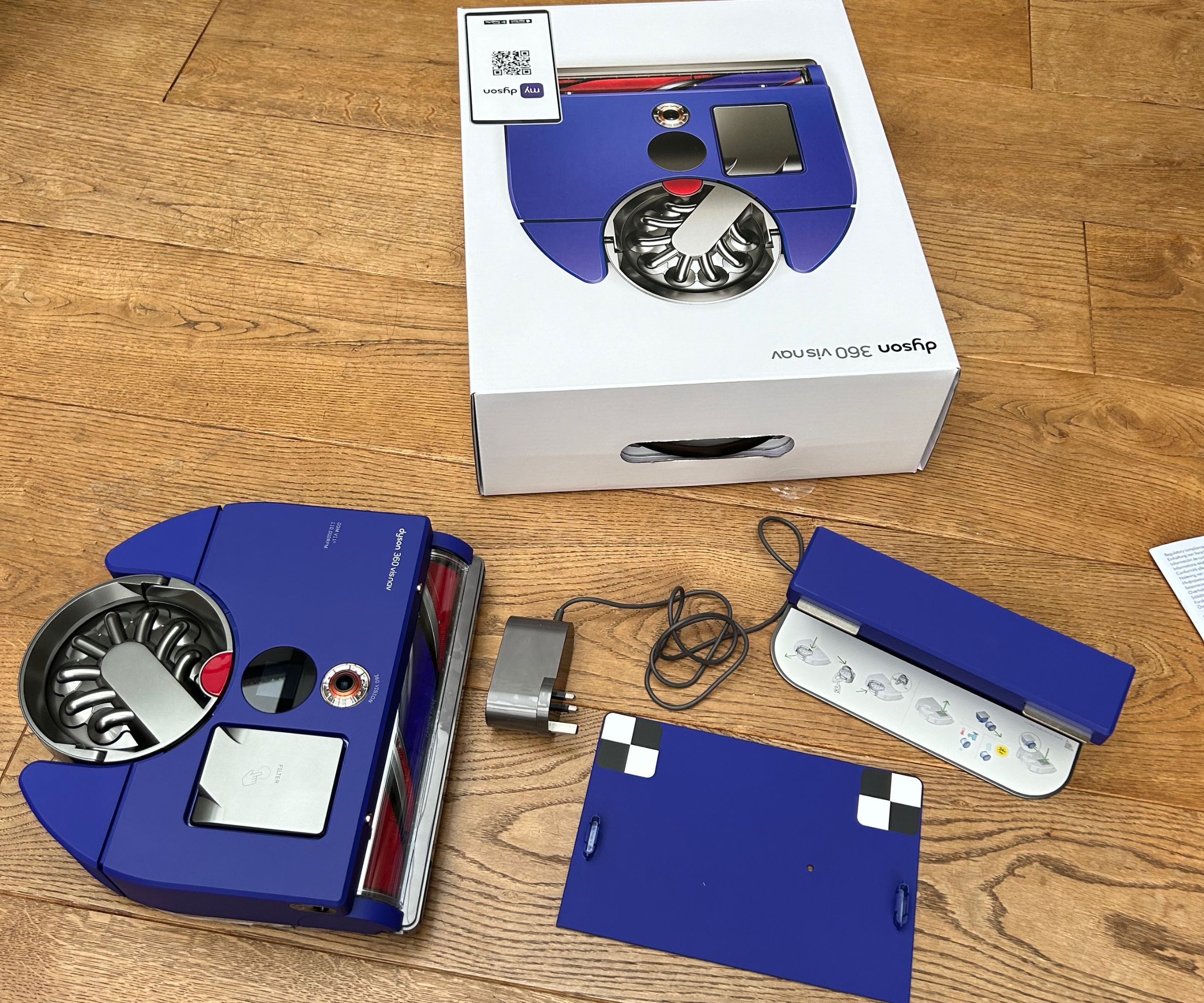
Unboxing the Dyson 360 Vis Nav
As you’d expect from a high-end brand, the Dyson robot vacuum arrived impeccably packaged, although the truly eco-conscious won't appreciate the protective molded plastic in the box. Nevertheless, removing it and assembling the charging station was swift.
There were two parts to click together and a charging cable to plug in, and then I simply needed to select a convenient spot to place the charging dock. It needs about 20 inches of free space on either side so that the robot can easily navigate back to its starting position.
While the robot charged up, I downloaded the free MyDyson app, which is crucial to get the most out of the robot vacuum and access all its features. Connecting the robot to the app was a seamless process and took just a few minutes. It’s definitely the easiest robot vacuum I’ve set up in several years of reviewing them.
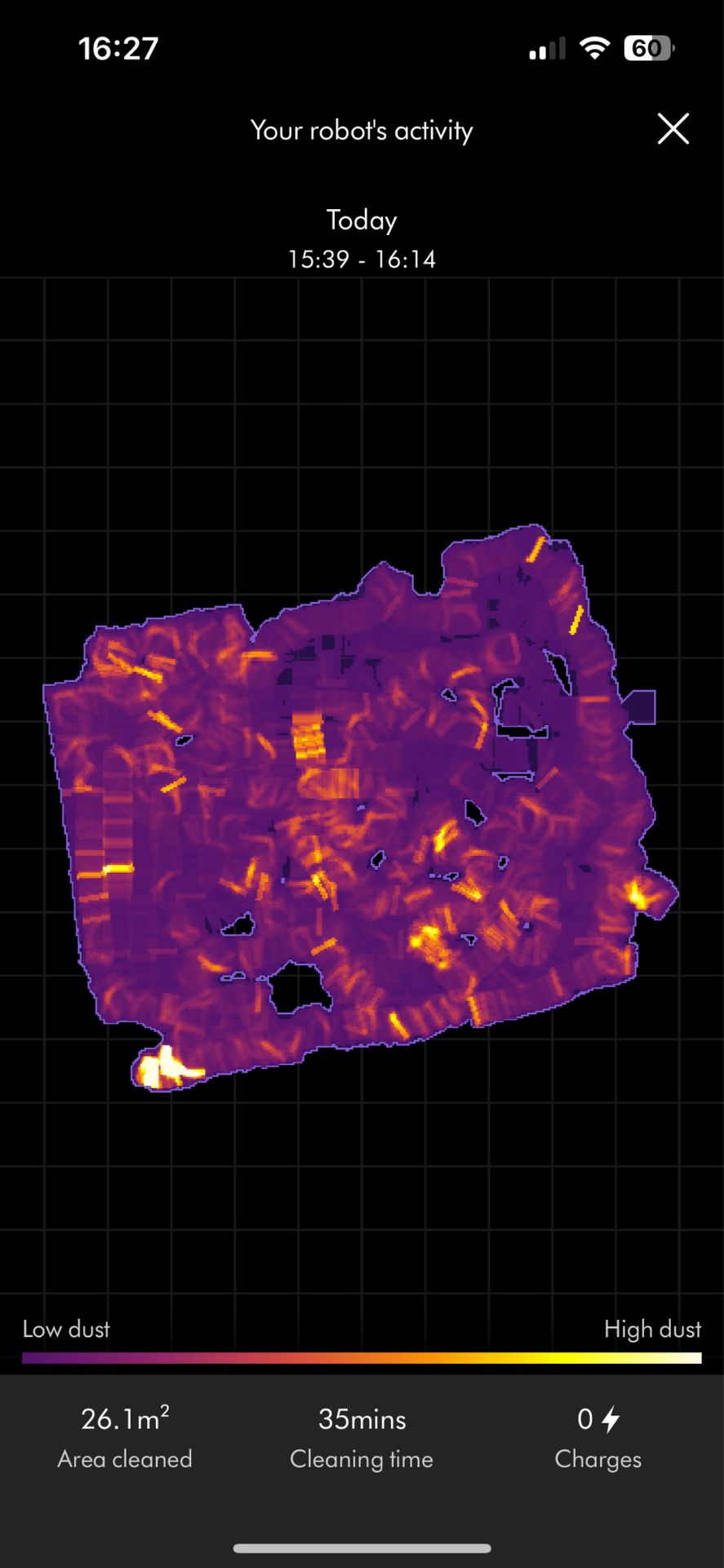
Screenshot of the MyDyson app
Once connected to the app, you can easily program a cleaning schedule, so that the robot will clean on certain days and times. You can also choose between the four power levels which are auto, quick, quiet, and boost.
The final task in setting up the robot is getting it to map your home. You can start mapping via the app, and during the process, the robot doesn’t vacuum, it concentrates on creating a map of your rooms including any obstacles like furniture. If you intend to use it in a split-level home, you’ll need to create a new map for each level.
I found the app intuitive to use and once the maps are set up, you can customize your floor plan by splitting it into rooms. Then, creating zones and no-go areas is straightforward. You can even set it to vacuum at a different suction level in each room.
Dyson has always been a floor-cleaning brand that focuses not only on performance, but also on the visual design of its appliances, and this Dyson robot is no different. The bright blue-purple color is a world away from the sea of black-and-white robot vacuums currently flooding the market. It also makes this robot easy to spot as it goes about its business. However, it will always need to be on display, so the vibrant color so it won’t be for everyone.
Dyson 360 Vis Nav: Design and features
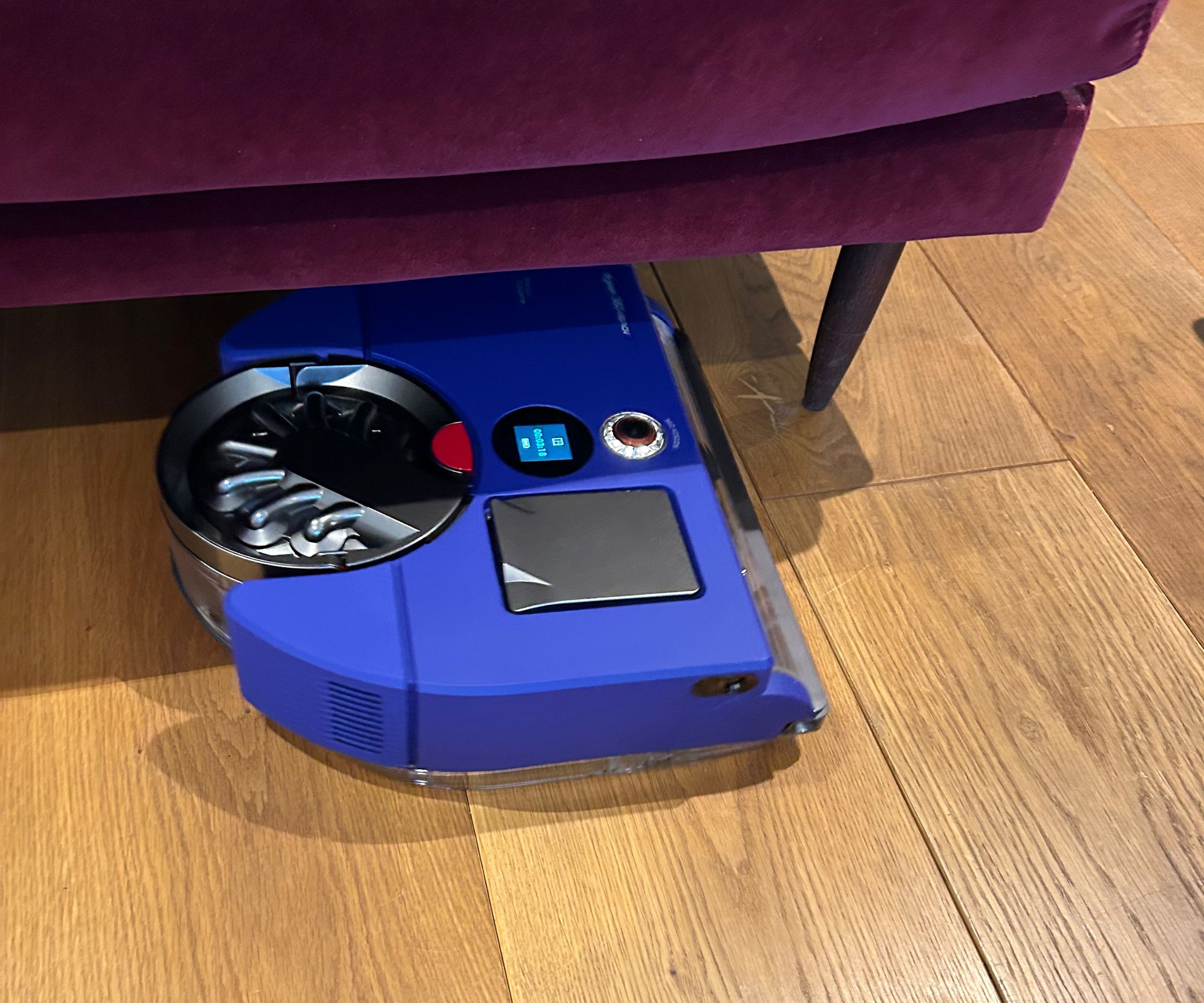
I tested the 360 Vis Nav on hard floors using flour and larger crumbs like oats
The 360 Vis Nav is a more basic cleaner than other robots in the market. There's no cleaning station, no mop, no fancy camera to see what's happening in your house like with the recently announced Switchbot K20+ Pro.
It simply vacuums – and Dyson calls it 'the world's most powerful robot vacuum.' Our home tech editor Dan Fauzi visited the Dyson labs once and they based this label off rigorous, standardized tests and found that the 360 Vis Nav does have the highest suction of any robot vacuum at the time it was released.
This doesn't mean it's the most effective cleaner however. Other robot vacuums can clean more thoroughly thanks to brushroll design, floor mapping and how it decides to tackle each section of the floor.
The robot vacuum has a runtime of up to 65 minutes before going back to the charging dock. And like most robot vacuums, it has 360-degree vision for navigation and it's controllable through an app, in this case the MyDyson app.
Test 1: Carpet
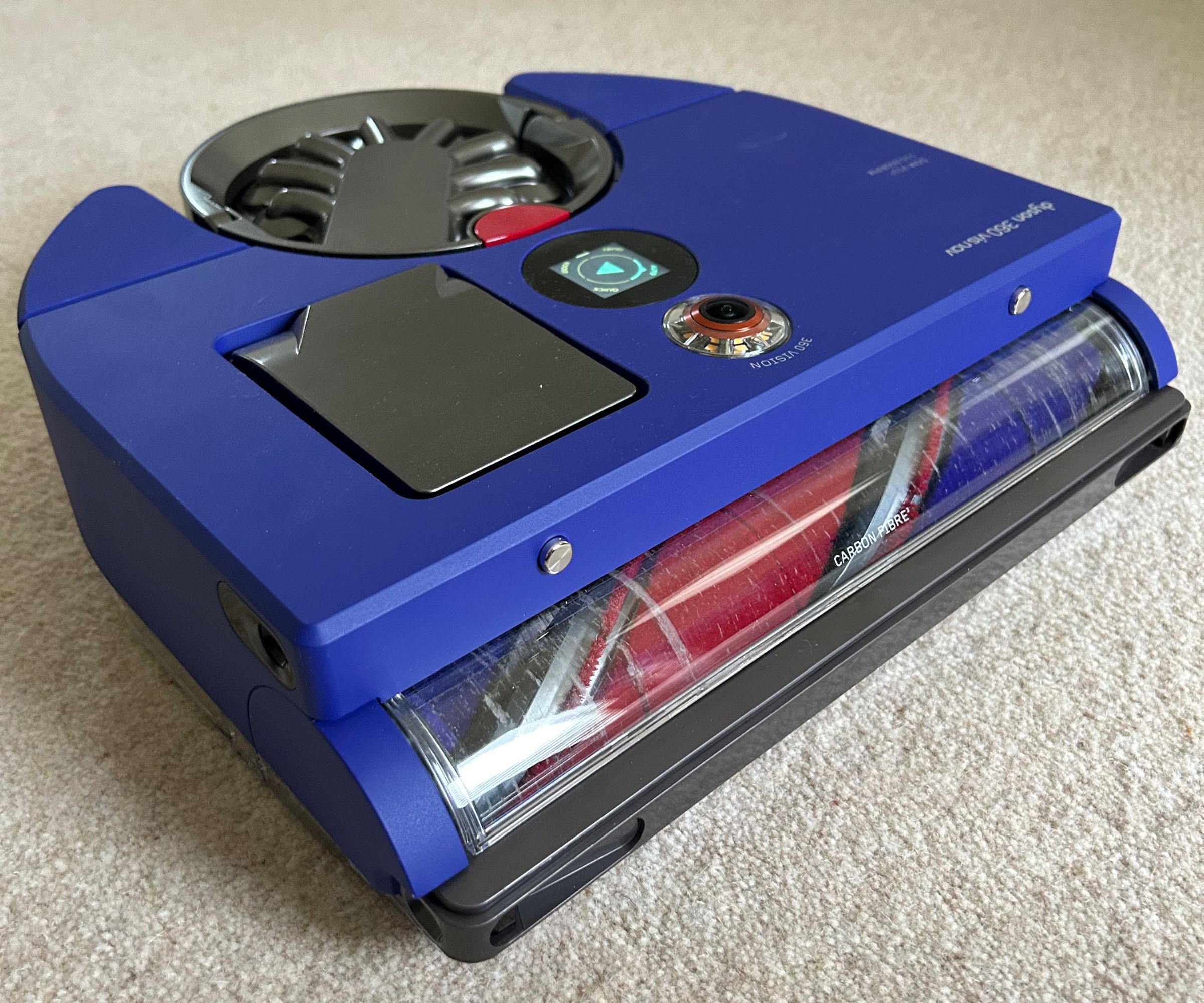
I tested the 360 Vis Nav on carpet using oats and crumbs
To find out if the 360 Vis Nav is a great vacuum for carpet, I used our classic test method of scattering oats and crumbs around the carpet to see how well it could pick them up. Having read the marketing info from Dyson, I was hopeful that this might be the first robot vacuum I’ve reviewed that efficiently cleans the edges of a room. But sadly, it seems even Dyson can’t engineer a robot that’s as good as a human using a vacuum.
I found that my carpets were generally left looking clean and refreshed, with all visible debris removed. However, I scattered some oats and crumbs along the baseboards to test edge cleaning, and the spill was only about 70% removed when vacuuming the room on auto mode, which is in line with the results on hard floors.
Having said that, I could see from the dust bin that while it didn’t necessarily remove all the surface debris I purposely scattered at the very edges, it did remove other deeper debris and fluff that I couldn't see.
Test 2: Hard floors
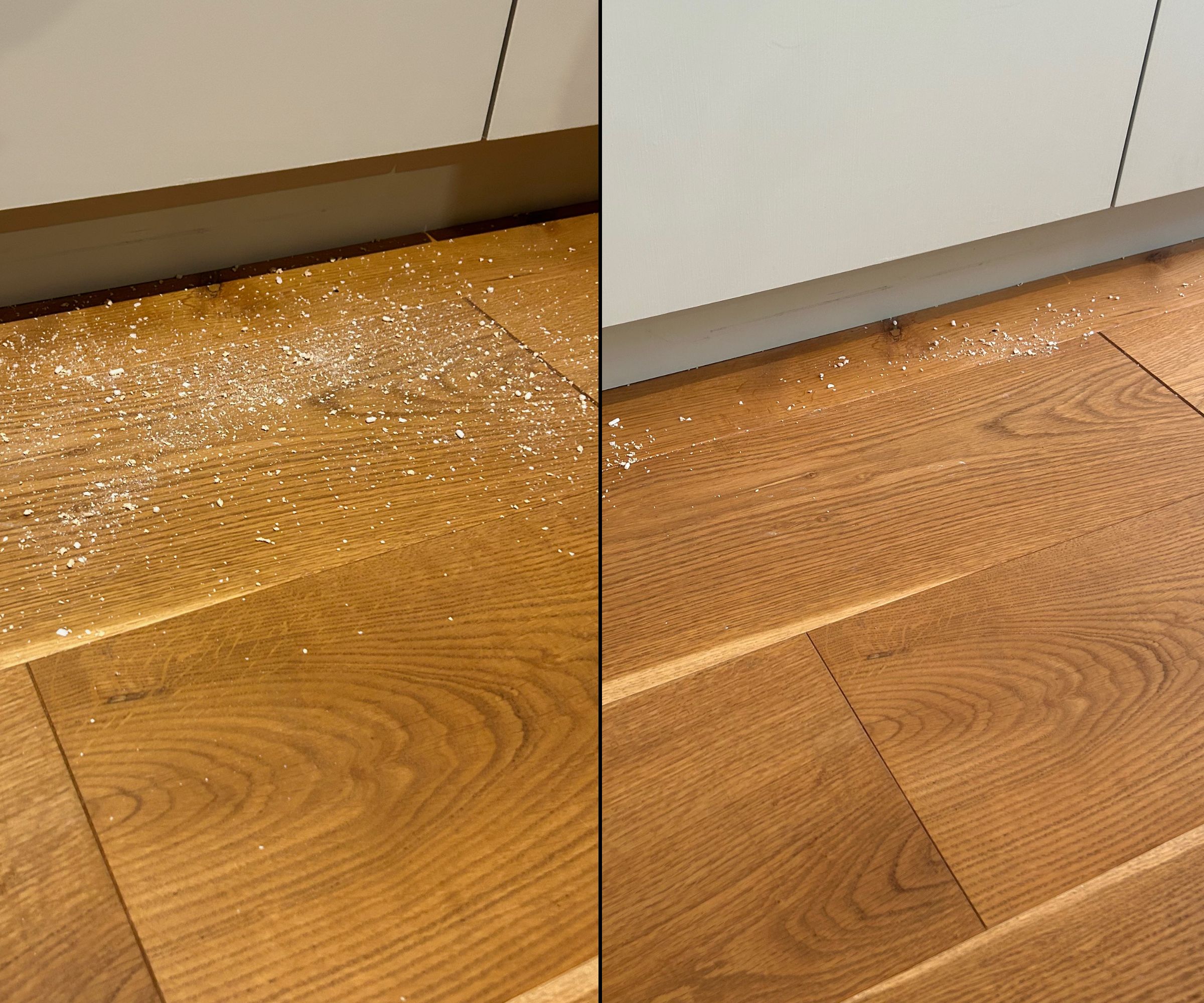
Before and after cleaning with the Dyson 360 Vis Nav
To find out if the 360 Vis Nav is a strong vacuum for hardwood floors, I scattered a mix of flour and larger crumbs like oats onto hard floors and a rug. I specifically made some of the spillages in corners, along baseboards, and around chair legs to see how well it collected the mess from different spots around the room.
At times it avoided furniture with a kind of swift maneuverability that I’ve rarely seen from other robot vacuums. When it did bump into something, it was more a light touch than a knock.
However, this wasn’t always the case, as a low profile lamp base proved more difficult for it to detect and avoid. And on one occasion it mounted the lamp base and spent a while figuring out how to maneuver away. That said, in general, it didn’t repeatedly and aggressively bash into all the furniture like many robot vacuums I’ve reviewed. I also found that it maneuvered with ease between cleaning wood floors and cleaning a thick pile area rug.
It doesn’t clean the room in systematic rows like my usual robot, and I must admit this seemingly random pattern made me dubious about its ability to thoroughly clean every inch of the floor. However, at the end of cleaning, a quick check of its activity in the app, shows a map of my floor plan, that details the level of dust it encountered across the entire floor space, giving me faith that it had covered the whole area.
Once it had cleaned the room and returned to the charger, I checked the results. The debris along the baseboard and into the corner of the room hadn’t been 100% removed, probably more like 80% in some cases. And around the leg of a sofa, it was only partially collected. Even a light sprinkle of crumbs wasn’t fully removed from the fibers of a long pile rug. So, I had to grab another vacuum and do it myself.
What is it like to use?
It avoided falling down any steps during the several times I used it upstairs. What’s more, it didn’t once get itself stuck anywhere or wedged into a tight spot and require rescuing, which is rare for a robot vacuum.
When vacuuming in auto mode, I could hear the suction level automatically increase to boost mode as it reached the debris. However it’s worth noting that this higher suction level also increases the fan speed and can, at times, blow some of the debris around the floor, similar to what we've seen in other robots like the Eufy S1 Pro Omni.
To double check this result and give it the best possible chance, I set up this test again and selected ‘boost’ mode for maximum possible suction. The results were similar though. And shockingly, this high suction mode drained the battery within just 12 minutes, so it had to return to the charger.
Each charge took approximately 90-100 minutes before it regained enough juice to carry on the clean. It returned to the charger twice when cleaning my 18 x 16 ft living room on boost mode. So all in all, the total clean took a desperately long 3 hours 42 minutes, and that's just for the living room, begging the question if a robot vacuum is really worth it at this price.
Thankfully, if you’re in a hurry and need the floors spruced up quickly before guests visit, there is a ‘quick’ mode and this took just 14 minutes to clean the same room. Although it did seem to avoid cleaning all the way up to the baseboards during this speedy clean.
On average it spent 30-37 minutes cleaning the room on auto mode. And from my experience with this vacuum, auto mode seems to be your best option. It’s the best compromise between prolonging battery life and achieving a decent clean.
The vacuuming time you’ll get when in auto mode will vary depending on how much dirt it encounters on your floors. Dyson says the Vis Nav can vacuum for up to 40 minutes in auto mode, which considering it took 30-37 minutes just to clean a 290 square foot room in my house, still means it’ll have to return to the charger several times to fully clean the main floor of an average home.
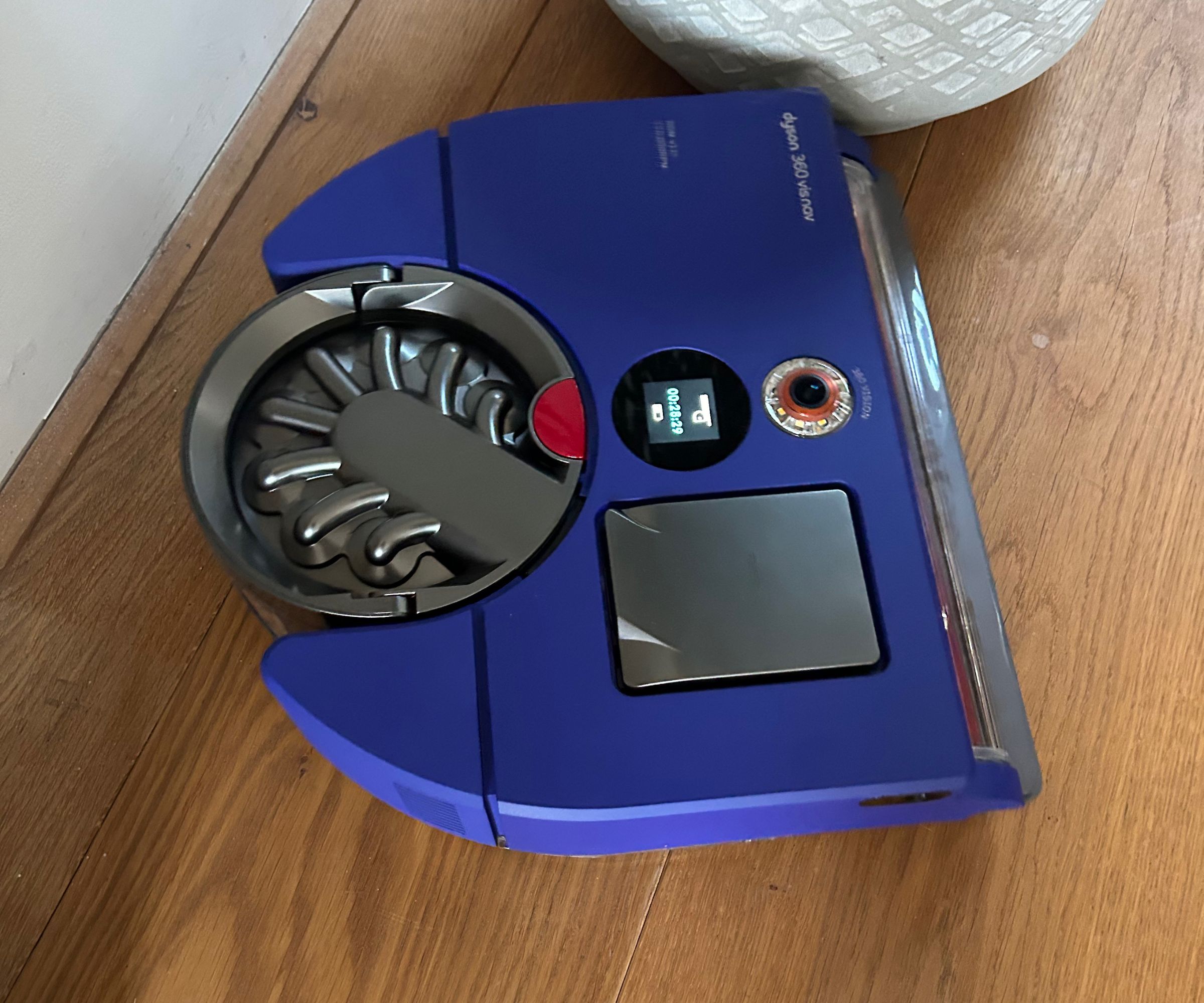
Vacuuming wooden floor
Having said that, I timed it on floors that were already pretty clean and it managed to vacuum for almost 60 minutes on auto before it returned to the charger. And on this occasion it only spent 45 minutes charging, before continuing the clean.
My home is more split level than most, with small steps between various rooms. So I had to make a couple of different maps for the different areas, and this proved pretty straightforward. The first few times I took it to another floor I also took the charging dock too. However, when I took it upstairs and left the charger downstairs, I discovered that it’s not possible to initiate vacuuming via the app unless the robot is on the charging dock.
This means that if you don't take the dock to other floors of your home along with the vacuum, then you can only start cleaning via the button on the top of the vacuum. And you therefore don’t get to make use of mapping functions, such as restricted areas, or different suction levels for different rooms.
Cleaning and maintenance
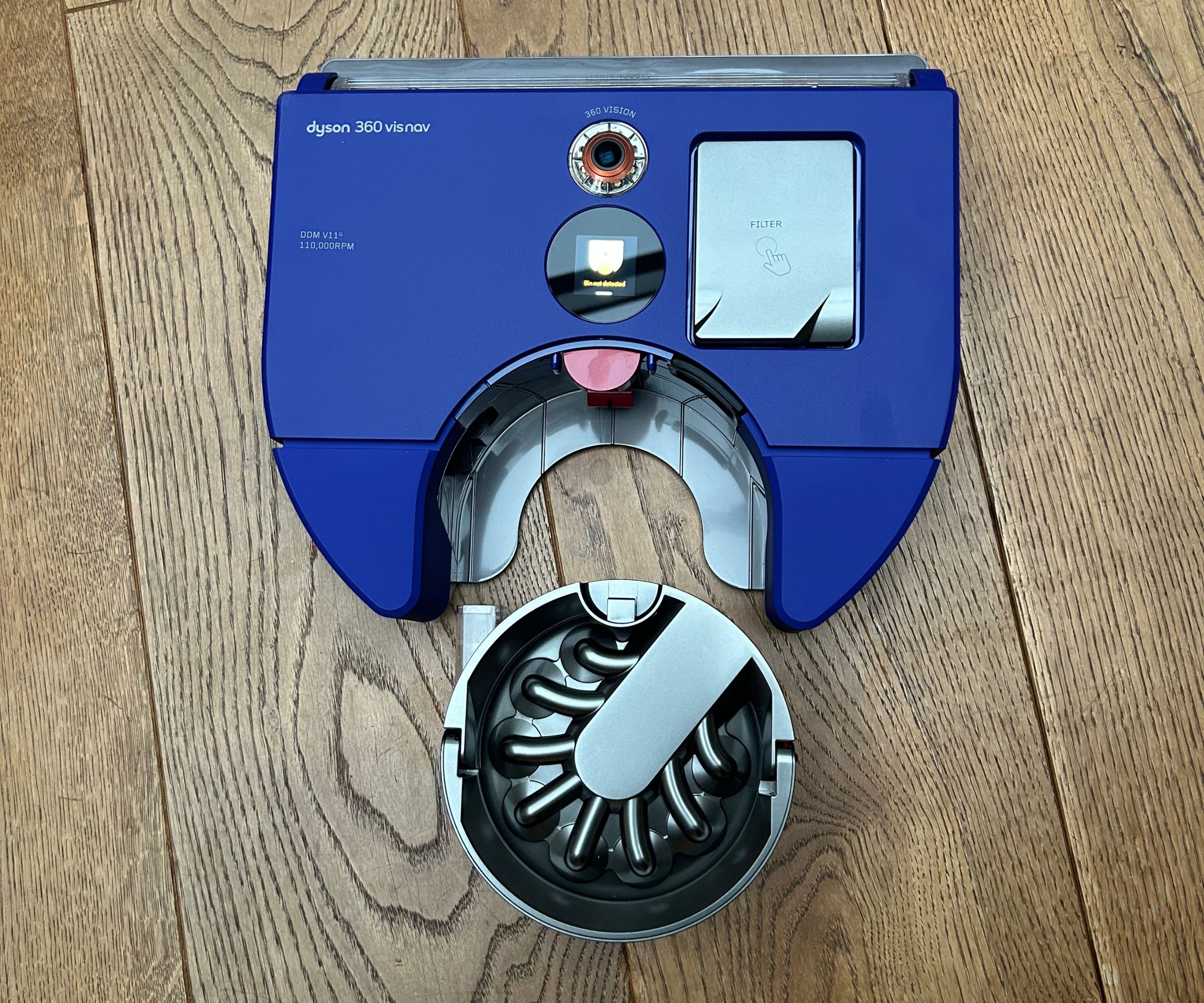
The circular dust bin detaches at the press of a button and you can carry it to the trash with the pop up handle. Then by simply sliding the switch on top of the handle, it automatically ejects all the dust and debris. It can also be wiped with a damp cloth should it need a more thorough clean.
Cleaning your robot vacuum cleaner becomes an easier task if the parts are easy to disassemble. The washable filter should, according to Dyson, be washed once a month. Pressing the top of the filter unit causes it to pop up. Then it’s just a case of lifting it out and removing the filter. Sensors also need a wipe on a monthly basis so it makes sense to do both jobs at the same time.
The brushbar is equally easy to remove and is washable. Though you’ll only need to do this if and when you think it needs a wash. Thankfully, my long hairs didn’t get wrapped around the brushbar, which saved me the job of cutting them away. All in all cleaning and maintenance is straightforward, with all parts easily accessible.
How does it compare?
If you’re not ready to put your trust in a robot and you’d prefer to do the cleaning yourself, I’d highly recommend taking a look at the Dyson Gen5detect. Not only is it cheaper than the Dyson 360 Vis Nav, but unlike a robot vacuum it can be used all around your home, from floors and upholstery to shelves and dog beds.
Alternatively, if you’re looking for additional functionality, the iRobot Roomba Combo J9+ has plenty to offer. Not only does it vacuum, but it also mops and empties its own dust bin. What’s more, the wood-topped charging base can even be used as a side table. So fans of a more understated design will probably prefer it to the more garish, colorful Dyson.
Should you buy the Dyson 360 Vis Nav?
Okay, here’s the thing, the Dyson 360 Vis Nav isn’t perfect, but no robot vacuum is. We’re a long way off these little independent floor cleaners matching up to a full size vacuum. But in comparison to other robot vacuums, it’s up there amongst the best for daily cleans.
I particularly like the user friendly app and easy setup. And if you schedule it to clean frequently, it’ll do a great job at tackling daily dust and dander. It’s just not the best option if you spill a box of oats or need to do a deeper clean.
It’s most efficient when used in auto mode, boost mode drains the battery far too quickly. And despite Dyson’s claims about its impressive edge cleaning, I was underwhelmed. That said, it’s a decent robot. Whether the price tag is justifiable though, will depend on your budget.
How did the Dyson 360 Vis Nav fare over time?
I continued to use the Dyson 360 Vis Nav for around six months after I finished testing. But in the end I reverted back to my older Eufy model, the Eufy X8 Pro. I found the eufy model was less temperamental, gave a more efficient and thorough clean, and on the whole was more user friendly.
The Dyson was a bit too clunky, bashing into some pieces of furniture more than I would like. It took longer to clean, too.
How I tested the Dyson 360 Vis Nav
I tested the Dyson 360 Vis Nav in my own home for two weeks. My home has a mix of carpets, area rugs and hardwood floors so I was able to find out how effectively the robot vacuum is able to clean different surfaces.
To gain a fuller understanding of the robot's abilities, I scatted oats, flour and crumbs across the house in varying places, like near furniture and baseboards, to see how it handles tighter spaces and edge cleaning.
Sign up to the Homes & Gardens newsletter
Design expertise in your inbox – from inspiring decorating ideas and beautiful celebrity homes to practical gardening advice and shopping round-ups.

Helen McCue is a freelance contributor who trained as a Home Economist. After starting her career in the food industry, she moved into home appliance reviews, utilising her cooking skills and experience to put all kinds of products to the test, and over the years has reviewed hundreds of home and kitchen appliances for a variety of publications.
Having completely renovated her current house, Helen reviews kitchen appliances from her open plan kitchen at home in a beautiful Berkshire village. When she’s not working, Helen can be found enjoying the local countryside or dreaming about her next house renovation project.
- Dan FauziHome Tech Editor
You must confirm your public display name before commenting
Please logout and then login again, you will then be prompted to enter your display name.
-
 Jennifer Aniston’s bedroom is a ‘goldmine of simple sumptuousness’ – it’s 2025’s version of quiet luxury and so easy to recreate
Jennifer Aniston’s bedroom is a ‘goldmine of simple sumptuousness’ – it’s 2025’s version of quiet luxury and so easy to recreateThe actress's unique space features James Mont-designed lamps and a raised bed inside a walnut plinth – but you can recreate its understated sophistication
By Megan Slack Published
-
 Zooey Deschanel and Jonathan Scott's breakfast nook is an innovative, effective use of kitchen space – it turns a 'dead area' into a cafe-style corner
Zooey Deschanel and Jonathan Scott's breakfast nook is an innovative, effective use of kitchen space – it turns a 'dead area' into a cafe-style cornerJonathan and Zooey have situated an eccentric yet elegant dining area in what may have been an otherwise underused corner
By Hannah Ziegler Published
-
 Kelly Ripa and Mark Consuelos's dining room shelves combine unexpected elements for the ultimate storage solution – it's multi-functional and replicable
Kelly Ripa and Mark Consuelos's dining room shelves combine unexpected elements for the ultimate storage solution – it's multi-functional and replicableGreen shelves in Kelly Ripa and Mark Consuelos' dining room cleverly combine storage to accomplish separate purposes in a pretty way
By Sophie Edwards Published